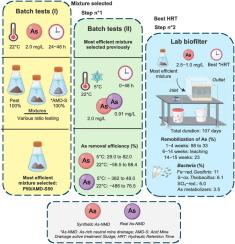温度和混合成分对富铁污泥和泥炭被动生物滤池去除中性矿井水中砷的影响
IF 4.1
2区 环境科学与生态学
Q1 ECOLOGY
引用次数: 0
摘要
在被动生物过滤器中,吸附是从富砷中性矿井水(As- nmd)中去除砷的主要机制,但促进其性能的生化过程需要更好地记录。本研究旨在评估两种当地可用的材料(泥炭和富铁酸性矿山排水处理污泥(md - s))对位于加拿大quacimbec北部的一个正在运营的金矿的As-NMD处理的适用性。首先,对不同泥炭与AMD-S混合物的效率进行了评价。在22°C和5°C下进行批量测试,使用合成(pH 7.16;2.0 mg/L As)和real (pH 7.63;0.91 mg/L As) As- nmd。结果表明,P50/AMD-S50混合物(50 wt%泥炭+50 wt% AMDS)对As的固定化效果最好。用P50/AMD-S50进行的进一步测试表明,合成As- nmd的As去除率(在22°C时为88%,在5°C时为82%)高于真实As- nmd(在22°C时为77%,在5°C时为48%),这归因于残余盐度。然后将P50/AMD-S50用于实验室规模的生物过滤器系统中,在连续模式下运行3个月(22°C;水力滞留时间1天)。在第一周内砷的去除效率最高可达98%,而在第27天后砷浸出。在生物过滤器样品中观察到好氧和厌氧细菌的混合物,包括铁还原剂(占总reads的11%),s-氧化剂(6.1%),SO42-还原剂(6.0%)和as代谢原核生物(3.5%)。为了确保污染物处理系统在实际矿山现场条件下的长期稳定性,从吸附剂中再活化As仍有待解决。本文章由计算机程序翻译,如有差异,请以英文原文为准。

Effect of temperature and mixture composition on arsenic removal from neutral mine drainage in passive biofilters using iron-rich sludge and peat
In passive biofilters, sorption is the main mechanism of As removal from As-rich neutral mine drainage (As-NMD), but biochemical processes contributing to their performance needs to be better documented. This study aims to evaluate the suitability of two locally available materials (peat and Fe-rich acid mine drainage treatment sludge (AMD-S)) for As-NMD treatment at an operating gold mine located in northern Québec, Canada. First, the efficiency of different mixtures of peat and AMD-S was evaluated. Batch tests were conducted at 22 and 5 °C using synthetic (pH 7.16; 2.0 mg/L As) and real (pH 7.63; 0.91 mg/L As) As-NMD. Results revealed that the P50/AMD-S50 mixture (50 wt% peat +50 wt% AMD![]() S) was the most efficient for As immobilization. Further tests with P50/AMD-S50 showed that As removal was higher for synthetic As-NMD (88 % at 22 °C, 82 % at 5 °C) than for real As-NMD (77 % at 22 °C, 48 % at 5 °C), which was ascribed to residual salinity. P50/AMD-S50 was then used in a lab-scale biofilter system operated in a continuous mode for 3 months (22 °C; hydraulic retention time 1 day). A maximum of As removal efficiency of 98 % was obtained within the first week while As leaching occurred after 27 days. A mixture of aerobic and anaerobic bacteria was observed in the biofilter samples, including Fe-reducers (11 % of total reads), S-oxidizers (6.1 %), SO42--reducers (6.0 %), and As-metabolizing prokaryotes (3.5 %). The remobilization of As from the sorbent remains to be addressed to ensure long-term stability of contaminant treatment systems under real mine site conditions.
S) was the most efficient for As immobilization. Further tests with P50/AMD-S50 showed that As removal was higher for synthetic As-NMD (88 % at 22 °C, 82 % at 5 °C) than for real As-NMD (77 % at 22 °C, 48 % at 5 °C), which was ascribed to residual salinity. P50/AMD-S50 was then used in a lab-scale biofilter system operated in a continuous mode for 3 months (22 °C; hydraulic retention time 1 day). A maximum of As removal efficiency of 98 % was obtained within the first week while As leaching occurred after 27 days. A mixture of aerobic and anaerobic bacteria was observed in the biofilter samples, including Fe-reducers (11 % of total reads), S-oxidizers (6.1 %), SO42--reducers (6.0 %), and As-metabolizing prokaryotes (3.5 %). The remobilization of As from the sorbent remains to be addressed to ensure long-term stability of contaminant treatment systems under real mine site conditions.
求助全文
通过发布文献求助,成功后即可免费获取论文全文。
去求助
来源期刊

Ecological Engineering
环境科学-工程:环境
CiteScore
8.00
自引率
5.30%
发文量
293
审稿时长
57 days
期刊介绍:
Ecological engineering has been defined as the design of ecosystems for the mutual benefit of humans and nature. The journal is meant for ecologists who, because of their research interests or occupation, are involved in designing, monitoring, or restoring ecosystems, and can serve as a bridge between ecologists and engineers.
Specific topics covered in the journal include: habitat reconstruction; ecotechnology; synthetic ecology; bioengineering; restoration ecology; ecology conservation; ecosystem rehabilitation; stream and river restoration; reclamation ecology; non-renewable resource conservation. Descriptions of specific applications of ecological engineering are acceptable only when situated within context of adding novelty to current research and emphasizing ecosystem restoration. We do not accept purely descriptive reports on ecosystem structures (such as vegetation surveys), purely physical assessment of materials that can be used for ecological restoration, small-model studies carried out in the laboratory or greenhouse with artificial (waste)water or crop studies, or case studies on conventional wastewater treatment and eutrophication that do not offer an ecosystem restoration approach within the paper.
 求助内容:
求助内容: 应助结果提醒方式:
应助结果提醒方式:


